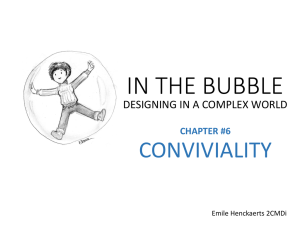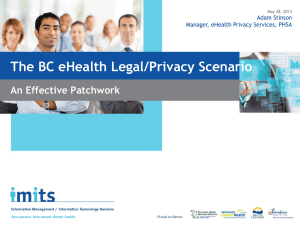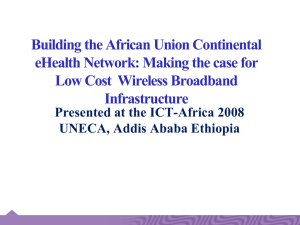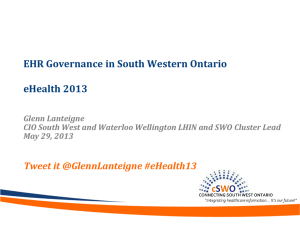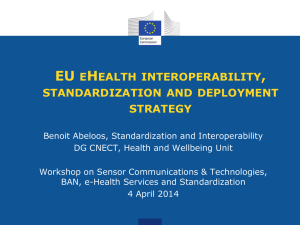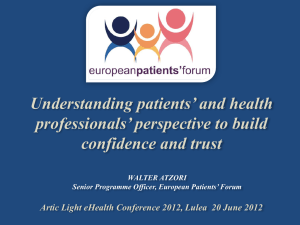r02_711_medinfo2013_..
advertisement
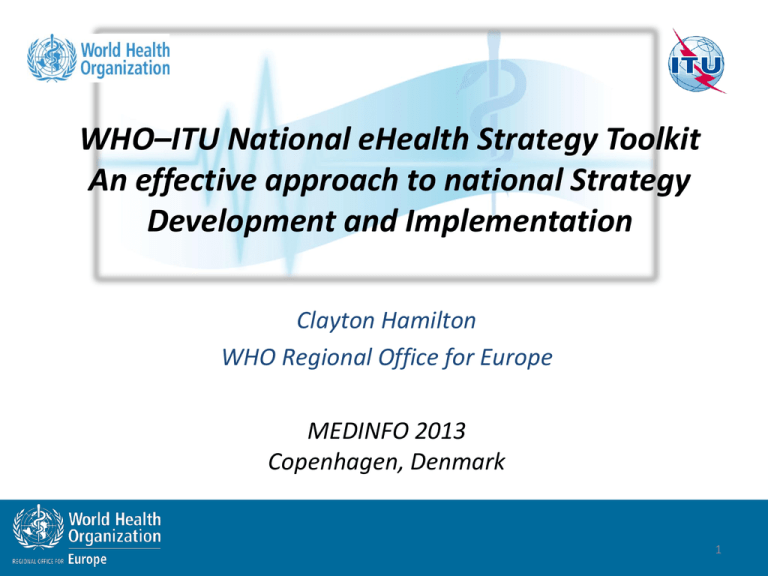
WHO–ITU National eHealth Strategy Toolkit An effective approach to national Strategy Development and Implementation Clayton Hamilton WHO Regional Office for Europe MEDINFO 2013 Copenhagen, Denmark 1 Role of a national eHealth strategy • Serves as an umbrella for planning and coordinating different national eHealth efforts… • …while considering fundamental elements in terms of regulatory, governance, standards, human capacity, financing and policy contexts. 2 National eHealth Strategy Toolkit • A resource for developing or renewing a country’s eHealth strategy • From countries just setting out to those that have already invested in eHealth • A framework and method for the development of a vision, action plan and monitoring framework 3 Why a toolkit? • National eHealth strategies are the pivotal tool upon which the launch, or refocusing of national eHealth programmes hinge. • The process of their development is difficult, time consuming and obviates “hard-to-coordinate” cross-sector ministerial commitment led by the Ministry of Health. • WHO and ITU could see countries grappling with the task of strategy development/ensuring stakeholder engagement and saw an opportunity to apply its best-practice knowledge. • The “obvious choice” was to formalize a flexible approach to explain the rationale for eHealth strategy creation and to help ensure the necessary aspects would be considered during the creation process. 4 Overview of the Toolkit National context for eHealth development Established ICT environment Strengthening eHealth enabling environment, create foundations Mainstreaming Developing and Building up Scaling-up and integration, costeffectiveness, policies for privacy, security and innovation Scaling up Emerging enabling environment for eHealth Governance, policy, standards and human resources Established enabling environment for eHealth Early adoption Strengthening infrastructure, make the case for eHealth Experimentation Source: http://www.who.int/goe/en/ Overall market and penetration of infrastructure Emerging ICT environment Overview of the process for defining a vision • The strategy process is a sequence of steps, with some done in parallel • The strategy is built from information and analysis done in each step, but the overall process is iterative 7 Link eHealth outcomes to the strategic context Health system goal or challenge: Health workforce shortages primarily affect rural and remote communities eHealth outcome Enable electronic access to appropriate health-care services for patients in rural and remote communities. Rationale Enabling individuals to access services through electronic means will partly compensate for health workforce shortages. Health system goal or challenge: To have halted by 2015 and begun to reverse the spread of HIV/AIDS in our country eHealth outcome Provide individuals with electronic access to the information they need about preventing HIV/AIDS and other diseases. Rationale Access to education and awareness information about HIV/AIDS and other STDs is an effective way to combat the spread of these diseases. 8 8 National eHealth components The eHealth environment is made up of components, or building blocks, which will be introduced or strengthened through the strategy. All components need to be considered, even if not addressed in the final eHealth strategy. 9 Framework for an action plan • The national action plan is based on groups of activities, or action lines, that provide a high-level view of the major areas of work • The quality, cost and availability of resources (local or international) will affect the scope, timing and delivery of activities • Phases and targets shape the feasibility of the plan and should be understood by stakeholders 10 Developing the national eHealth action plan: overview • • • An initial plan is drafted based on the vision and recommendations developed in Part 1 The draft is refined based on constraints (such as resources and funding) and the eHealth environment This approach ensures that the plan is grounded in the current context, but is not overly constrained 11 2. Developing an eHealth monitoring and evaluation framework: overview 2.1 Indicators eHealth output and outcome indicators that show the results that eHealth delivers 2.2 Measures Baseline and target measures for each indicator 2.3 Governance Processes for monitoring and evaluation of eHealth adoption and associated results 12 Define a process for national monitoring and evaluation Describes the process for monitoring and evaluation during the implementation of the action plan, including the governance. 13 Risks? Weaknesses in the approach? The successful execution of a resulting eHealth strategy can and will be influenced by factors that are often volatile and difficult to predict at the time of strategy derivation. i.e. Political support received by the Ministry of Health and the Ministry for ICT for implementing the proposed objectives, changes in government or the composition thereof, sustainable funding mechanisms, support from the donor community, impact upon any ongoing eHealth initiatives There is some provision to counteract these intangible factors but they are always present and can “derail” or “direct”. 14 Conclusion The WHO-ITU national eHealth strategy toolkit should be considered as an excellent resource for countries to use in approaching the design and execution of their own eHealth strategies, and as an effective tool to help ensure that the directions taken, and investments made by governments, achieve the maximum value possible for their citizens. 15
